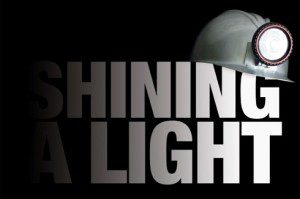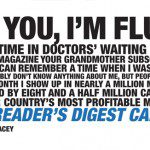Shining a Light
The editor who fell down the elevator shaft and other tales, trials and misconceptions from the subterranean depths of the trade press
In a prospector’s camp, Bob Richards reads by oil lamp about the toil behind a modest Newfoundland mine. The story of Duck Pond and its deep sedimentary rocks captivated him – this, he thought, is how Canada was built. The article moved him to contact the author. “Madame,” he wrote, “I bow to your journalistic talent and my hat touches the ground as I salute you. Thanks to you I have seen the Duck Pond installation the same or even better than my own eyes would have seen had I been there.”
His letter appeared, not in a Pierre Berton book, but in the September 2006 issue of the magazine I’m here to delve into today. Concorde Place ends in a cul-de-sac where I squint up at a giant gleaming Lego cube, all reflective glass and yellow pillars. Ensconced on the seventh and eighth floors of this quadrangular maze is the Business Information Group (B.I.G.), one of the country’s largest trade publishers. The Canadian Mining Journal lies in this quarry, and I haven’t brought a hard hat.
They don’t appear on the same newsstand as their consumer cousins, but that doesn’t mean trade magazines haven’t been around for a while. The Miner is 125 years old, the Grocer 121. At first it seems the Jeweller, at 128, holds the title of oldest, but here’s the Sportsman, claiming to be 137. By the end of the 19th century, almost every industry had at least one magazine serving it. According to CARDonline, bible to Canada’s media buyers, there are 944 trade magazines in the country, if you count the nearly 100 farm periodicals. By some definitions, at least, you’re reading a trade book right now. So, maybe it’s time to visit the relatives.
Shinning a Light2The B.I.G. reception area is quiet and spare. I ask for Jane Werniuk and take a seat beneath the inspirational pictures on the wall: dandelions, trees, words like “innovate” and “create.” It’s been 20 years since Werniuk landed the job of CMJ editor; she did take seven years off to spend with her children, after which she returned to the fold to “inspire” and “connect.” The elevator dings and a bespectacled woman with short-cropped hair and a good-natured smile emerges. She swipes her security card at the door, and I’m in.
The warren unfolds before me: a parallel universe that’s invisible to all but its target industries. I walk by Service Station & Garage Management, Oral Health Journal and Pulp & Paper Canada, grey cubicles grouped by magazine sector into a pioneer wagon ring that encircles the bank of elevators at the building’s core. Here, the products aren’t called “trade” books but rather “B2B” (business-to-business publishing). But stereotypes persist on the outside- especially from those who aspire to “Great Journalism.” These trades, the voices hiss, have low journalistic standards. They employ just about anyone who can string together a sentence. Worse, they’re boring.
Werniuk doesn’t seem to mind: it’s better than getting treed by a bear at work. In the summer of 1981, she was a reconnaissance geologist in the Yukon when she encountered an ursine stranger. “It was a small bear,” she admits. “And I thought, this is neat, I’m actually seeing my own bear. But maybe if I’m smart, I should just go up a tree and get out of harm’s way, just in case.” She left her backpack behind, so the bear tried to eat her leftover pudding cup and her camera. Then it began nosing at her boots. Werniuk fired a flare and soon a helicopter rescued her. “It was my last bush summer,” she says. “I decided I had to find something else to do.”
She dabbled in textbook editing before answering an ad for a CMJ editorial assistant. Two days after her wedding, she went in for an interview and within three years was at the helm of the magazine. She didn’t consider herself an exceptional – or fast – writer (though Bob the Duck Pond fan may disagree), so she took some courses at Magazines University, an annual conference held in Toronto, to complement her MA in geology. A trade editor needs both technical knowledge and journalism experience, she says, and either one can be picked up along the way. “Automotive, plastics, forestry – it’s just as technical as mining.”
After graduating from journalism school in 2002, Nicole Axworthy was advised that if she decided to go into trades, she should “try not to stay there for too long, otherwise you get sucked in and you can’t get out.” She spent a year and a half as an assistant editor at Engineering Dimensions. “I didn’t know anything about the subject, but apparently that wasn’t really necessary. I knew how to write and edit.” (After all, as Werniuk told me, “It’s not good to have engineers writing magazines.”) Axworthy’s starting salary was $40,000 – not bad for a first job. “I worked with lawyers and engineers…all 40-year-old, pocket-protector-with-glasses type guys. I’m sure it’s good for some people if you really enjoy the subject.”
She could be talking about Andrew Ross, editor and publisher of the automotive magazine Jobber News, who went to his first motor race when he was three weeks old. “It’s more to me than just the job,” he says. “B2B is a lot of people’s second choice, but they stayed with it.” He shrugs. “It’s not a bad life.”
Axworthy took a $2,000 pay cut when she left Engineering Dimensions for WeddingBells and the now-defunct Fashion18. “Definitely the content is vastly different,” she says, “but trades are a lot more stable, because they have a specific audience that they’re targeting, and there are always going to be people reading that magazine.” Recently, she learned about the instability of consumer books when she was laid off, but regrets neither her move out of the trades, nor the experience she gained there. “You learn how a magazine actually works,” she says, “and it’s usually a smaller team, so you get your hands in everything.”
Most trades are bare-bones operations, in part because their publishers expect higher profit margins. Special interest publications aside, consumer magazines have an average profit margin of 9.2 per cent, compared to 11.9 for trades, according to Statistics Canada. Staff sizes range up to 25 but many B2Bs employ only one or two people on the editorial side, and share art and circulation departments. A trade’s average circulation is a little less than 16,000 (CMJ has 10,000). CAmagazine – for chartered accountants – leads the pack with paid circulation of more than 75,000.
Like Axworthy, Michelle Morra, the former editor of Canadian Occupational Safety, believes that a stint in “business press boot camp” would help any journalist. Writing in the May/June 2006 issue of Masthead, the mag trade handbook, Morra – who is now freelancing on the consumer side – asked consumer editors to set aside their prejudices. Trade writers bring fresh and creative energy to the consumer press, she wrote: “When you’ve made something nice out of an ugly subject, you can write the pretty stuff standing on your head.”
In 1997, a mining company named Bre-X began its plummet into bankruptcy and notoriety after its exaggerated gold prospects in Indonesia made the front page. Investors lost billions. CMJnever ran a story on the scandal. “We just kinda left it alone,” says field editor Marilyn Scales. Werniuk says she didn’t want to run anything on the affair because “it was a big mess and I wasn’t going down to view the court cases. And there was no definitive end to it.”
Scales says she has neither the time nor the energy for investigative journalism: “I might’ve when I was younger, but I’ve reached an age in my career where I need a good boot to get moving.” CMJ commissions an Argentine columnist to write about corporate social responsibility, but most of the topics discussed – sustainable development, company reports – are neither contentious nor specific to Canadian mining.
Eighty-five to 90 per cent of trades are distributed through controlled circulation and free to executive and supervisory personnel, so it’s no surprise that advertising accounted for 81 percent of the industry’s 2003 revenue, according to Statistics Canada. Many B2B editors regard readers, sources and advertisers as friends: after conventions, they talk shop over beer. But Ross says he balks at selling covers and writing flattering corporate profiles. “Because I was already here for a long time before I got the publisher’s job,” he explains, “people don’t ask me for things they know I can’t and won’t give them.”
John Cumming, editor of CMJ’s sister publication, The Northern Miner, acknowledges the pressure in trade publishing to be “cozy” with advertisers. One time, Silvercorp Metals Inc. paid for a trip to a mine in China and a five-star hotel stay, and then a freelancer wrote critically about its safety measures. He’d “rather not get into” the furious phone call he then got from the company, saying, “That’s just part of the job.” But Peter Carter, the editor of Today’s Trucking, says he’s never felt compromised: “Doing stories about advertisers isn’t going to last no matter what field you’re in.” The goal of any B2B book is explicit, Carter says. “We are more than anything an advertising vehicle, but that’s not a bad thing.”
B.I.G. and its competitor, Rogers Communications Inc., have watchdog editorial committees to discuss ethical conflicts. Lou Smyrlis heads the committee at B.I.G., which tries, he says, to meet quarterly to debate issues such as advertorials. “We don’t have the power to say, ‘Editors shall not do this,'” he says. “It’s all in an advisory capacity.” The council doesn’t recommend splitting covers with ads, but has approved company-sponsored supplements.
Editorial misgivings go back a long way. As the editors of Printer’s Ink observed in the 1880s, “support was to be had only by cultivating the vanity of manufacturers.” Trades strive to appeal to both readers and advertisers. “The best way to serve the advertiser is to serve the reader first,” Smyrlis says. “They don’t want to read a publication that appears to be a complete sellout.”
Ken Steele, a regular CMJ reader and regional geologist who works for the Ontario government, is philosophical about this balancing act: “Most of the people in the industry understand. They know who the players are and what biases may be there. Everybody’s got to have ads to survive.” Besides, says McIntosh Engineering draftsman Gary Lister, “I enjoy reading the advertising too.”
Werniuk candidly admits she ignores miners with shady reputations. “I know that’s cowardly, but our sole support is advertising. We try to encourage people to do the right thing, but tend not to skewer people as much as we would like to. You can’t get too edgy.”
What would Benjamin Taylor Bell, CMJ’s resident muckraker in 1887, think of that? Werniuk keeps his picture on her desk, after all. “He was sued every year,” she says fondly of the fiery founder. “He was constantly going after the bad actors.” Men with interesting facial hair gaze imperiously from the fraying yellow pages of those early CMJs, their faces accompanied by titles of long-winded articles (“Some Notes on the Economic Geology of the Skeena River”) and chemistry textbook illustrations.
By Bell’s heyday, the business press was already more than a century old, born along with the United States and its emerging industries – railroads, textiles, pharmaceuticals. CMJ started in 1882 as the Canadian Mining Review, five years before The Canadian Groce r& General Storekeeper, launched by a young man named John Maclean, later joined by his brother Hugh, who eventually broke their fraternal partnership. Hugh started his own publishing company, which was bought by Southam Inc. in 1960, then acquired by Hollinger Inc., and in its current incarnation – B.I.G. – is owned by Glacier Ventures. John didn’t do so badly either. Maclean-Hunter Ltd. Flourished until 1994, when it was swallowed by Rogers, which today owns 42 trades to B.I.G.’s 43.
Every August, Werniuk meets with Scales and publisher Ray Perks to plan the editorial calendar for the following year. Upcoming themes include oil sands and special provincial issues. With a freelance budget of $6-7,000 a year, the bulk of the writing is done by Werniuk and Scales, who is based in Ottawa.
Scales has seen gold recovery methods change and improve. She can recall when iron was last mined in Quebec and silver in British Columbia, and was the first reporter to visit the lead-zinc mine on Little Cornwallis Island in Nunavut’s north. This depth of knowledge (often hunted down by general reporters on deadline) is what keeps trade readers loyal. “The focus is not on controversy,” Smyrlis explains, “but on providing people with enough educational material so they can make a decision about what is right for their company.”
Satisfying readers’ appetite for information is what wins magazines the highest B2B accolades: the annual Kenneth R. Wilson Awards, with categories including Best Merchandising/Marketing Article and Best Profile of a Company. CMJ has received an honourable mention, but most go to titles such as CAmagazine, Marketing and Canadian Lawyer. Automotive and health magazines, such as The Medical Post and OHS Canada – known for their in-depth journalism – also regularly appear among the top five. Solid Waste & Recycling broke a story about a post-Hurricane Katrina landfill posing an environmental hazard.
Editors agree that readers function as factcheckers when trades don’t have the budget for it, although Werniuk is open about CMJ’s practice of handing entire stories back to companies for vetting before publishing. When readers write in, Scales observes, “Ninety-nine times out of 100 they’re pointing out a mistake.”
When I peek into then art director David Young’s cubicle, he’s struggling with the design for a profile of De Beers Canada CEO Jim Gowans. Young has only one photo of Gowans for the cover, but what about the inside spread? “I really don’t know,” he mutters, staring at the layout. “Put him on this page again and make him green?” He ends up repeating the picture, juxtaposed with a map of Canada. To save money, Werniuk and Scales take their own pictures and mining companies provide most other visuals. “It may sound cynical,” Young says with a sigh, “but almost no one cares what this looks like.”
The elevators are working, so I only find out that the power’s gone out when I step into the dark reception area. It’s an appropriate time to think of Benjamin Taylor Bell and the peculiar manner in which he made his final exit. Bell liked to take a shortcut through a neighbouring store to get to work, but on February 18, 1904, he somehow walked through the wrong door and fell down an empty elevator shaft.
Andrew Ross materializes before I can scare the receptionist, or myself, and it’s a few steps to a long boardroom that’s less austere in the dimness. There is chatter, and fruit platters and Pickle Barrel napkins strewn across the table for a casual lunch. I eye the open boxes of cakes and cookies as I pull up a chair and try to decide which clique to join. A man across the table is telling a story about how he’s related to “that Holmes on Homes guy.” Others are wondering if it’s okay to go home. “Oh crap,” someone says, “he’s going to keep us here ’til five.”
And then, as if remembering who I am, someone asks, “You’re not writing all this down, are you?” I mime scribbling in my notebook and murmur, “They… were… all drunk…” Laughter all around. For one brief moment, I command the water cooler. “People will just be coming in droves to work here,” says Ross with a grin. “We’d be heroes again.”














